Planting blueberries

Blueberries are appreciated not only for the pleasant taste of the berries, but also for their healing properties. Under natural conditions, culture is found in many regions of the country. However, thanks to breeders today, any summer resident can grow a garden variety on his personal plot.
The cultivated species is unpretentious. Nevertheless, some recommendations should be taken into account in order to ensure good survival of the seedlings and get a decent harvest. Consider the features of the correct planting of blueberries, the nuances of site preparation and some other points that gardeners should know about.


Timing
In the spring
This is the best time to plant blueberries outdoors. The plant will have time to take root and get stronger before winter. Therefore, it can more easily withstand a strong drop in temperature. When the snow has completely melted, the buds will not bloom yet, but the earth has already warmed up to + 5 ° C, you can think about placing seedlings on the site. However, it should be borne in mind that the climate of different regions has significant differences. Therefore, experts advise focusing on the conditions of a particular area. For example:
- in the southern regions, the procedure should be carried out at the end of March;
- in the middle lane and central Russia, landing can be carried out in mid-April;
- in the Urals, Siberia and other cool regions, you should not leave plants outside until early May.
After planting, the ground around the bush should be mulched. If there is a danger of night frost, it is better to cover the plant with a spunbond. At the same time, it is important to understand that the culture planted in the country in the spring will not bloom and will not bear fruit in the near future. The first harvest should be expected only next year.
It happens that young plants are brought to garden shops even before the onset of spring. In this case, the question arises of how to store the seedlings in winter, so that by the time of planting they remain strong and healthy. A refrigerator or cold basement is a bad idea. Lack of light will have a bad effect on the condition of the plants.
The best solution is to place the young bushes in a cool but well-lit place, such as a balcony door. In early spring, you can take out the seedlings to the insulated loggia.


In autumn
This time cannot be called the best for planting a culture. In the event of an early onset of cold weather, a bush that did not manage to take root in a new place may not withstand the temperature drop. Even if the winter is expected to be harsh, you shouldn't risk it. On the other hand, if the blueberries have time to take root and gain strength before frost, it will be possible to wait for the first harvest with the onset of the warm period. Therefore, some gardeners still choose this planting option.
In this case, it is worth making every effort to reduce the risk of damage and death of the plant. To do this, it is advisable to place the seedling in the ground in mid-autumn, long before the first frost. In this case, it is worth removing all weak shoots. For strong branches, it is best to cut them in half. In addition, after immersing the bush in the ground, it is necessary to carefully mulch the near-trunk circle. The seedling itself must be covered with burlap or non-woven fabric.
If a shrub with a closed root system is sold in a container, it can be sent to the ground at any time, even in summer (with the exception of especially hot days, which are not suitable for such work). When planting such a plant, the transshipment method is used. This minimizes the stress of moving, and also increases the likelihood of the bush taking root in a new location.
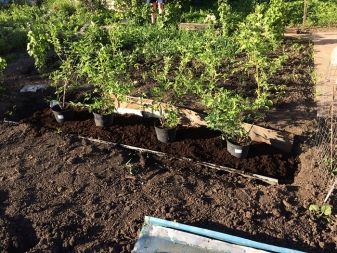

Sapling selection
The best solution is to choose a plant at the age of 2-3 years, which has a pronounced annual growth. Of course, older bushes look stronger. However, such specimens take root less well in a new place. The seedling must be absolutely healthy and well developed. Roots and shoots should not have any warning signs (suspicious spots, cracks, damage of various nature).
If the plant is sold in a container and purchased just before planting on the site, its roots should look out of the holes in the bottom of the container. This is a sign that the seedling has grown enough and is ready to expand the area by moving it into the open ground. Varietal diversity should not baffle the grower. It is always best to purchase the varieties of culture that are most suitable for a particular region.
With a perfect match, the bush will not have to adapt to unusual climatic conditions. Accordingly, it will grow and bear fruit better.
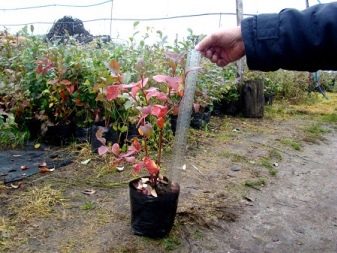
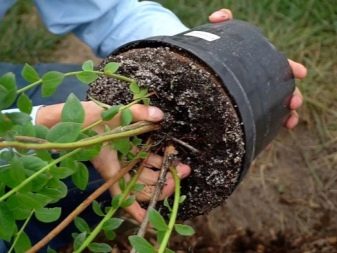
A place
Garden blueberries love light. With its lack, culture does not develop well. It also negatively affects the taste and size of the fruit. Therefore, when choosing between areas in the sun and in the shade, it is better to give preference to the first option. Let's say the choice of a place located on a small hill. The main thing is that it is reliably protected from the cold north wind. You can plant a bush next to a house, a gazebo or any other structure (preferably on the south side).
Neighbors
Plants with certain characteristics should be planted next to this crop. They must love acidic soil and have deep roots (so as not to interfere with the shallow root system of blueberries). Ideal compatibility is obtained with fir, pine, juniper. If we consider berry bushes, lingonberries, blueberries, cranberries, currants, viburnum are perfect. It is not recommended to place blueberries next to raspberries, gooseberries, currants.
Vegetables that prefer neutral or alkaline soil will not be good neighbors for a berry crop. We are talking about cabbage, eggplant, beets, carrots, pumpkin, melon, beans and others. It will be uncomfortable for the shrub under fruit trees that take nutrients and create shade. But the gardener can create a beautiful composition by combining blueberries and ornamental plants in one area.
For example, you can use hydrangea, rhododendrons, azalea, buttercups, lupins, lilies of the valley, ferns, thuja. In addition to beauty, such a neighborhood will also provide excellent shrub pollination and increased yields.
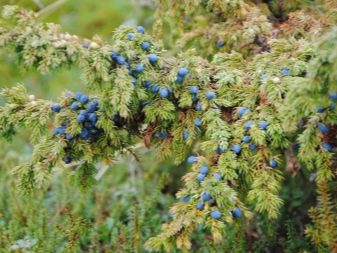
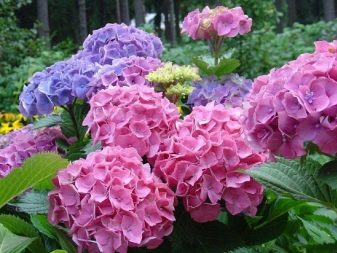
The soil
The crop is very sensitive to soil composition. As already mentioned, she prefers light soils with a strong acid reaction. The most preferred options include peat, sandstone, sandstone, loam. Rotted foliage can be an excellent natural fertilizer. This additive helps to maintain a sufficient level of moisture and makes the soil more fertile. If necessary, the pH level can be artificially shifted to the acidic side.
Another important point is that planting a bush in a lowland is undesirable. Also, a plot with closely lying groundwater is not suitable for growing. High drainage properties of the soil are very important for this crop. If the waters pass in deep layers, the superficial root system will not come into contact with them. If the upper layers of the soil are waterlogged, this can lead to plant disease.
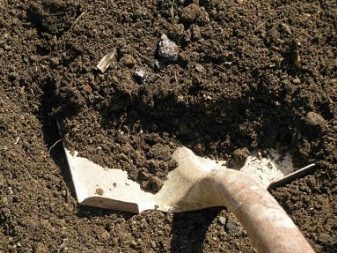
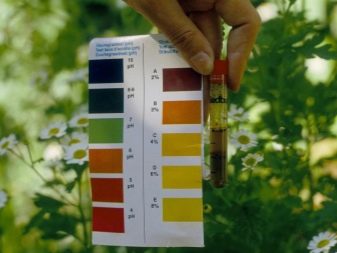
Planting pit preparation
It is better to prepare a hole for the bush in advance (a couple of weeks before planting). First, it is worth making a depression in the soil with a size of 0.9 m and a depth of 0.5 m. Most often, the roots of the culture are located 30 cm below the surface of the earth. Therefore, you cannot make the hole smaller.It is necessary to provide the seedling with sufficient space for full growth and development. Then you need to make drainage by mixing fertile soil with needles, moss, bark, small broken branches. After that, mineral fertilizers containing nitrogen and sulfur should be added to the hole. Organic matter cannot be used for soil enrichment. Fallen needles and sawdust of coniferous trees are an exception. Moreover, they must be rotted, since fresh ones will take nitrogen from the soil.
You can acidify the soil with a special mixture from the store. You can also use vinegar and lemon juice in moderation. The pH should be 3.5-5.0. You should not be too zealous (reddening of the leaves of the plant will indicate excessive acidity). If the soil in the area is alkaline, the hole should be lined with non-woven material. This will prevent leaching of the soil, artificially brought to the desired state. Otherwise, the pH will gradually change, and the bush will begin to ache and wither.
At the end, the hole must be covered with a special mixture (a combination of loam, high peat and sand) and left until planting. During this time, the formation of an optimal environment and a good water-air balance will occur in the soil.
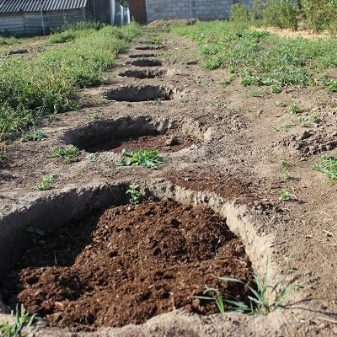

Landing scheme and technology
To get the maximum yield, you need to plant the crop correctly. Usually, not one, but several copies of blueberry seedlings are purchased. The optimal distance between bushes depends on the selected variety. Miniature varieties can be planted 0.8-1 m apart. Medium and large varieties require more space. Between such bushes it is worth leaving 1.3-1.5 m.At least 2 m should be kept between the rows.This is extremely important, since thickening of the plantings can lead to a decrease in the quality of the fruit and a deterioration in immunity due to a lack of light. Some gardeners are wondering if it is possible to plant different varieties of crops together. Their doubts are in vain. Placing several varieties of blueberries in a summer cottage will only increase yields through cross-pollination.
Now we will consider the features of planting young bushes in dug trenches. First of all, you need to prepare each seedling. Do not plant specimens with tangled and curved roots. Such bushes do not have enough strength for full development, so they will not bear fruit. In some cases, the plants even die, so it is important to avoid such troubles. To do this, some time before planting, the seedlings should be immersed in water for 15 minutes (you can do this without taking the plants out of the containers). Then you need to carefully remove the bushes from the containers, knead the earth clods and untangle the roots. After that, you can start planting. Let's consider a step-by-step algorithm.
- At the bottom of the hole, you need to put drainage (if this has not been done earlier), filling it with suitable soil.
- A seedling is placed in the center. The roots must be carefully straightened, and the root collar must be buried 5–8 cm below ground level.
- Then it is worth watering the plant abundantly (you can use both pure water and a solution of a root formation stimulator).
- After that, the hole must be covered with soil, lightly tamping it.
- It is better to prune the tops of the shoots. This will stimulate lateral branching.
- At the end, the surface of the soil around the bush should be mulched with coniferous sawdust or oak leaves (layer thickness - 8-10 cm). The mulch will retain moisture and keep weeds out.
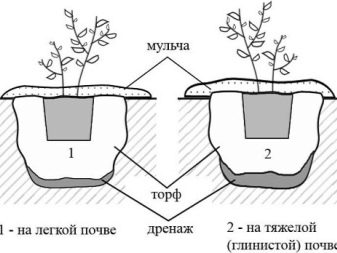
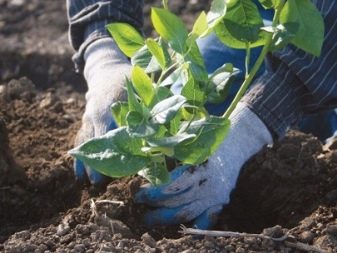
Frequent mistakes
Several of the most common mistakes can be identified, due to which garden blueberries grow poorly in areas, get sick and do not produce fruits:
- buying weak seedlings;
- the wrong choice of a place for planting (shade, an area with high humidity);
- placing plants in unsuitable soil (low acidity, heavy clay soil, poorly permeable to air and moisture);
- non-compliance with the planting scheme (too close arrangement of bushes);
- lack of drainage in the holes with plants;
- ignoring advice on deepening the root collar;
- an attempt to do without mulching the soil around the planted bushes;
- undesirable neighborhood for blueberries (planting a number of crops that negatively affect the shrub).
Any of these failures can negatively impact crop health. Therefore, it is important to pay attention to all the nuances, even if they seem insignificant. Of course, do not forget about the appropriate care for the planted shrub.
Only if all the recommendations are followed will the gardener be able to enjoy the magnificent appearance of blueberries and a rich harvest of healthy berries.
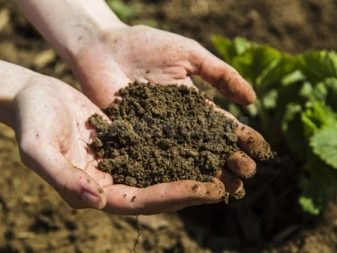
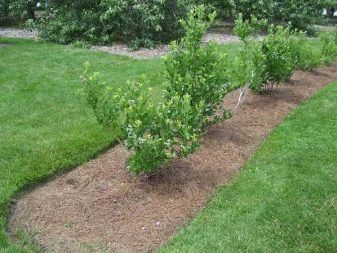













The comment was sent successfully.